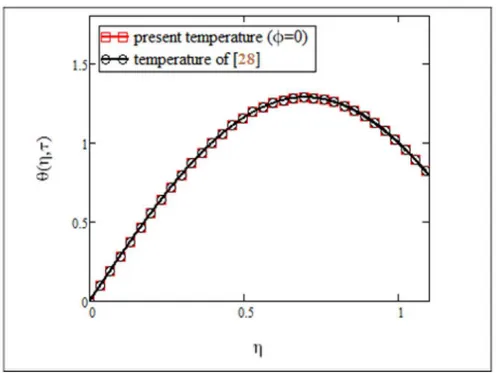Heat Transfer in MHD Mixed Convection
Flow of a Ferrofluid along a Vertical Channel
Aaiza Gul1, Ilyas Khan2*, Sharidan Shafie1*, Asma Khalid1,3, Arshad Khan1
1Department of Mathematical Sciences, Faculty of Science, Universiti Teknologi Malaysia, UTM Skudai, Johor, Malaysia,2College of Engineering, Majmaah University, Majmaah, Saudi Arabia,3Sardar Bahadur Khan Women’s University, Quetta, Pakistan
*sharidan@utm.my(SS);ilyaskhanqau@yahoo.com(IK)
Abstract
This study investigated heat transfer in magnetohydrodynamic (MHD) mixed convection flow of ferrofluid along a vertical channel. The channel with non-uniform wall temperatures was taken in a vertical direction with transverse magnetic field. Water with nanoparticles of magnetite (Fe3O4) was selected as a conventional base fluid. In addition, non-magnetic
(Al2O3) aluminium oxide nanoparticles were also used. Comparison between magnetic and
magnetite nanoparticles were also conducted. Fluid motion was originated due to buoyancy force together with applied pressure gradient. The problem was modelled in terms of partial differential equations with physical boundary conditions. Analytical solutions were obtained for velocity and temperature. Graphical results were plotted and discussed. It was found that temperature and velocity of ferrofluids depend strongly on viscosity and thermal ductivity together with magnetic field. The results of the present study when compared con-curred with published work.
Introduction
The idea of using small-sized solid particles inside fluids to increase their thermal conductivity
was initially initiated by Maxwell [1]. This idea was based on suspension of micro-sized or
milli-sized solid particles inside fluids. Subsequently, however it was realized that large sized particles in the milli- scale or even micro-sized particles causes several technical problems. For example, (i) faster settling time, (ii) clogging micro-channels of devices, (iii) abrasion of
sur-faces (iv) erosion of pipelines and (v) increasing drop in pressure [2]. Based on these problems,
Choi [3] came up with the idea of improving thermal conductivity using nano-sized particles.
More specifically, Choi experimentally verified that the addition of nanoparticles in conven-tional based fluids enhances the thermal conductivity and the mixture which was composed of base fluid with suspended nanoparticles named as nanofluid. Besides, higher thermal conduc-tivity, the addition of nano-sized particles over micro-sized particles to conventional base fluid was preferred due to several valid scientific reasons such as (i) longer suspension time (more stable), larger surface area/volume ration (1000 times larger), (iii) lower erosion and clogging, (iv) lower demand for pumping power (v) reduction in inventory of heat transfer fluid, and
(vi) significant energy saving [4].
OPEN ACCESS
Citation:Gul A, Khan I, Shafie S, Khalid A, Khan A (2015) Heat Transfer in MHD Mixed Convection Flow of a Ferrofluid along a Vertical Channel. PLoS ONE 10(11): e0141213. doi:10.1371/journal.pone.0141213
Editor:Saeed Islam, Abdul Wali Khan university Mardan Pakistan, PAKISTAN
Received:May 15, 2015
Accepted:October 5, 2015
Published:November 9, 2015
Copyright:© 2015 Gul et al. This is an open access article distributed under the terms of theCreative Commons Attribution License, which permits unrestricted use, distribution, and reproduction in any medium, provided the original author and source are credited.
Data Availability Statement:All relevant data are within the paper.
Funding:The authors have no support or funding to report.
Nanofluids have numerous applications in nano-scale flow. In this type of flow the molecu-lar structure of the fluid and surfaces, andinteraction between them at the atomistic length scale play a key role and hence the molecular dynamics (MD) method emerges as a viable approach for investigation of the flow in such scale. Examples of nano-scale flows include bubbfil spinning, bubble electrospinning, blown bubble spinning, membrane spinning pro-cesses used for nanofiber fabrication. Bubbfil spinning is a nanoscale flow process in which polymer/melts, bubbles/membranes are used for fabrication of nanofibers by using electrostatic force, flowing air or mechanical force (e.g. centrifugal force) to overcome the surface tension of
bubble[5]. Chen et al. [6]studied bubbfil spinning process for mass-production of nanofibers.
He et al. [7] analyzed various characteristics of Nanoscale flow with some interesting results.
On one hand, some commonly used fluids such as water, ethylene glycol, and mineral oils are found to have poor thermal characteristics when compared with metals, non-metals and their oxides. On the other hand, it is noticed that the flow analysis of nanofluids with the inter-action of magnetic field have increased enormously. Perhaps this could be due to the numerous industrial and engineering applications of nanofluids. There are three categories which
describe how a material is equivalently affected by a magnetic field. There are three types of magnetic materials namely: (i) Diamagnetism: materials such as copper, lead, quartz, water, acetone, and carbon dioxide are diamagnetic. These materials are very weakly affected by
mag-netic fields, (ii) Paramagnetism: materials such as sodium, oxygen, iron oxide (FeO or Fe3O4),
and platinum are paramagnetic. They are affected somewhat more strongly than diamagnetic materials, and become polarized parallel to a magnetic field (iii) Ferromagnetic: ferromagnetic
materials include gadolinium, iron, iron oxide (magnetite) (Fe3O4), and nickel, cobalt ferrite
(CoFe3O4) and manganese bismuth (MnBi). These materials are very strongly affected by
mag-netic fields. In addition, they become strongly polarized in the direction of the magmag-netic field and retain their polarization state after the magnetic field is removed. Together, all these three
types of materials are called magnets or ferromagnetic materials [8]. Ram and Kumar [9]
noticed that temperature of the ferrofluids decreases with the increase of viscosity radiation parameter. The magnetohydrodynamic stagnation point flow of a nanofluid over a stretching/
shrinking sheet with suction was studied by Mansur et al. [10]. It was found that temperature
of the ferrofluids decrease with the increase of viscosity radiation parameter. Colla et al. [11]
investigated Water-BasedFe3O4nanofluid characterization: thermal conductivity and viscosity
measurements and correlation. Colla and Ram have found the same results of viscosity
varia-tion with the temperature. Abareshi et al. [12] studied fabrication, characterization and
mea-surement of thermal conductivity ofFe3O4nanofluids. Borglin et al. [13] studied
experimentally the flow of a ferrofluid in porous media.
Amongst these three types, ferromagnetic materials produce a strong magnetic field.
There-fore, in the present work, we had chosen nanoparticles of magnetite (Fe3O4), being the most
commonly used magnetic material and water was chosen as a conventional base fluid. The resulting fluid was called ferrofluid also known as magnetic fluid. More specifically, ferrofluids are colloidal suspensions of small magnetic particles in a carrier liquid. Some important uses of ferrofluids are found in mechanical damping in loudspeakers and in heat exchangers.
Based on the importance of ferromagnetic materials, Qasim et al. [14] examined MHD flow
with slip condition in the presence of heat transfer in ferrofluid over a stretched cylinder with
given heat flux. They used water as conventional base fluid and added magnetite (Fe3O4)
nano-particles. For the sake of comparison they also added non-magnetic (Al2O3) nanoparticles to
the base fluid. Khan et al. [15] tackled a stagnation point problem of ferrofluid along a
stretch-ing sheet with viscous dissipation and heat transfer. They considered ferroparticles of three
types: magnetite (Fe3O4), cobalt ferrite (CoFe3O4), andMn−Znferrite (Mn−ZnFe3O4).
results for these two types of base fluids after using implicit finite-difference method with quasi-linearization technique as the solution to a resultant problem. By using ferrofluid,
Shei-kholeslami and Ganji [16] investigated heat transfer with thermal radiation inside an enclosure
of semi annulus in the presence of a magnetic source. Idress et al. [17] studied application of
the optimal homotopy asymptotic method for the solution of the Korteweg-de Vries equation.
Ellahi et al. [18] studied series solutions of non-Newtonian nanofluids with Reynolds' model
and Vogel's model by means of the homotopy analysis method. Herisanu and Vasile [19]
inves-tigated that optimal homotopy perturbation method for a non-conservative dynamical system of a rotating electrical machine. Several other studies were conducted in the last few years, on nanofluids by taking different types of convectional base fluids with different nanoparticles, see
for example [20–29] and the related references therein.
The above literature review revealed that no study has yet to be conducted on heat transfer in mixed convection flow of ferrofluid inside a vertical channel in the presence of a magnetic field. Also, the interaction of magnetic field with magnetite nanoparticles in a mixed
convec-tion flow, presents an interesting fluid dynamics problem [30]. Therefore, this study specifically
investigates the behavior of water suspension which contains nanoparticles of magnetite
(Fe3O4) making as ferrofluid together with heat transfer analysis due to mixed convection. In
this problem non-magnetic (Al2O3) nanoparticles were also used and a comparison between
magnetic and non-magnetic nanoparticles is conducted. Analytical solutions are obtained, plotted graphically and discussed.
Problem Formulation and Solution
In formulating the problem, this study considered water-based nanofluid containing magnetite (Fe3O4) nanoparticles. Pressure gradient of oscillatory type was applied in the flow direction. Free convection in the presence of radiation effect was also considered. Mixed convection flow
was induced inside a vertical channel of widthdwith constant temperature. Fluid was
electri-cally conducted due to magnetic fieldB0of strengthB0applied in a transverse direction to the
flow. Magnetic Reynolds number chosen was small and induced magnetic field was neglected. External electric field and electric field due to polarization were taken as zero. Top boundary of
the channel was maintained at constant temperatureTwwhile the bottom boundary had a
uni-form temperatureT0. Channel was taken along thex−axis andy−axis was taken as normal to
the flow direction.
Based on the approximation of Boussinesq and taking into consideration the above assump-tions, the governing equations of momentum and energy obtained are as follows:
rnf@v @t¼
@p
@xþmnf
@2v @y2 snfB
2
0vþ ðrbÞnfgðT T0Þ; ð1Þ
ðrcpÞnf@T
@t ¼knf
@2T @y2
@q
@y; ð2Þ
with boundary conditions
vð0;tÞ ¼0; Tð0;tÞ ¼T0; ð3Þ
vðd;tÞ ¼0; Tðd;tÞ ¼Tw; ð4Þ
wherev=v(y,t) denotes thefluid velocity in thex−direction,T=T(y,t) is the temperature of
the nanofluid,ρnfis the density of the nanofluid,μnfis the dynamic viscosity of the nanofluid,
expansion of the nanofluid,gis the acceleration due to gravity,knfis the thermal conductivity
of the nanofluid, (cp)nfis the specific heat of the nanofluid at constant pressure,qis the
radia-tive heatflux inx−direction, anddis the width of the channel. With reference to
[14,15,22,26], the relations of density, dynamic viscosity and thermal conductivity of the
nano-fluid with corresponding basefluid are given as:
ðrcpÞnf ¼ ð1 φÞðrcpÞf þφðrcpÞs; rnf ¼ ð1 φÞrf þφrS;
snf ¼anfðrcpÞnf;ðrbÞnf ¼ ð1 φÞðrbÞf þφðrbÞS;
mnf ¼ mf ð1 φÞ2:5;
knf kf
¼ðksþ2kfÞ 2φðkf ksÞ ðks 2kfÞ þφðkf ksÞ
;
ð5Þ
whereφis the volume fraction of the nanoparticles,ρfis the density of the basefluid,ρsis the
den-sity of the solid nanoparticles,μfis the dynamic viscosity of the basefluid,kfandksare the
ther-mal conductivities of the basefluid and solid nanoparticles respectively, (cp)fand (cp)sdenote the
specific heat at constant pressure corresponding to the basefluid and solid nanoparticles. The
total term (ρcp) is termed as heat capacitance. According to Turkyilmazoglu [26], the relations in
Eq 5are restricted to nanoparticles with spherical shape. For nanoparticles of other shapes with
different thermal conductivity and dynamic viscosity,Eq 5would be modified accordingly. The
corresponding ferrofluid or nanofluid thermophysical properties are given in Tables1and2.
These properties would be used in numerical computations of this problem [14,15,22]. However,
these values would be required in numerical computations, when plotting graphs.
Based on Makinde and Mhone [30], the radiative heat flux is as follows:
@q
@y¼4a
2
0ðT T0Þ; ð6Þ
whereα0is the mean radiation absorption coefficient. Applied pressure gradient in theflow
direction was taken as−@p/@x=λεexp(iω1τ), whereλis constant andω1is the frequency of
oscillation.
Table 1. Spherical and cylindrical shaped nanoparticles with dynamic viscosity and thermal Conductivity.
No Shape of Nanoparticles Dynamic Viscosity Thermal Conductivity
1 Spherical mnf¼ mf
ð1φÞ2:5
knf kf ¼
ðksþ2kfÞ2φðkf ksÞ ðks 2kfÞþφðkf ksÞ
2 Spherical μnf=μf(1 + 7.3φ+ 123φ2) kknf
f ¼
ðksþ2kfÞ2φðkf ksÞ ðks 2kfÞþφðkf ksÞ
3 Cylindrical mnf¼ mf
ð1φÞ2:5 knf
kf ¼ ðksþ1
2kfÞ 1 2φðkf ksÞ ðks 12kfÞþφðkf ksÞ
4 Cylindrical μnf=μf(1 + 7.3φ+ 123φ2) knf
kf ¼
ðksþ12kfÞ 12φðkf ksÞ ðks 12kfÞþφðkf ksÞ
doi:10.1371/journal.pone.0141213.t001
Table 2. Thermophysical properties of base fluid (water) and nanoparticles (iron oxide and alumina oxide).
Model cp(kg−1K−1) ρ(kgm−3) k(Wm−1K−1) β×10−5(K−1)
H2O 4179 997.1 0.613 21
Al2O3 765 3970 40 0.85
Fe3O4 670 5180 9.7 0.5
The following dimensionless variables are introduced:
x¼x d;Z¼
y d;u¼
v U0
;t¼tU0
d ;P¼ d
mU0
p;y¼ T T0
Tw T0
;o¼do1
U0 ; @P
@x¼lεe
io1t
; ð7Þ
The system of equations (1)–(4) is reduced to:
a0 @u
@t¼lεe
iot
þ2@ 2u
@Z2 m 2
0u a1y; ð8Þ
uð0;tÞ ¼0; uð1;tÞ ¼0; t>0 ð9Þ
b0 @y @t¼
@2y @Z2þb
2
1y; ð10Þ
yð0;tÞ ¼0; yð1;tÞ ¼0; t>0; ð11Þ
where
φ1 ¼ ð1 φÞ þφ rs rf
" #
; φ2¼
1
ð1 φÞ2:5
" #
;
φ3¼ ð1 φÞrf þφ ðrbÞs
bf
" #
;φ4 ¼ ð1 φÞ þφ
ðrcpÞs ðrcpÞf
" #
;
Re¼U0d
v ; a0¼φRe; a1 ¼φ3Gr; M
2¼snfB 2 0d
2
mnf ; Gr¼
gbfd2ðT
w T0Þ nfU0
;
N2¼4d 2a2
0
knf
; Pe¼ðrcpÞf kf
;ln¼ kf knf
;b1 ¼ ffiffiffiffiffiffi
N2 ln s
;b0¼
Peφ4 ln :
HereM, Re,N,Pe, andGrdenote magnetic parameter, Reynold's number, radiation parameter,
Peclet number and thermal Grashof number, respectively. Other arbitrary constants were used
for the sake of simplification.
In order to solve Eqs8–11, solutions of the forms
uðZ;tÞ ¼ ½u0ðZÞ þεexpðiotÞu1ðZÞ; ð12Þ
Using Eqs12and13in Eqs8–11, the following system of ordinary differential equations are obtained:
d2u 0ðZÞ
dZ2 m 2
1u0ðZÞ ¼a2y0ðZÞ; ð14Þ
u0ð0Þ ¼0;u0ð1Þ ¼0; ð15Þ
d2u 1
dZ2 m 2
2u1ðZÞ ¼ l; ð16Þ
u1ð0Þ ¼0;u1ð1Þ ¼0; ð17Þ
d2y 0ðZÞ
dZ2 þb 2
1y0ðZÞ ¼0; ð18Þ
y0ð0Þ ¼0;y0ð1Þ ¼1; ð19Þ
d2y 1ðZÞ
dZ2 þm 2
3y1ðZÞ ¼0; ð20Þ
y1ð0Þ ¼0;y1ð1Þ ¼0; ð21Þ
where
m1 ¼
m2 0
φ2
; m2¼
ffiffiffiffiffiffiffiffiffiffiffiffiffiffiffiffiffiffiffiffiffi
m2 0þioa0 p
;m3¼
ffiffiffiffiffiffiffiffiffiffiffiffiffiffiffiffiffiffiffi
b1 iob0 p
; a2¼
a1
φ2 :
Solutions of Eqs18–21yield
y0ðZÞ ¼
sinb1Z
sinb1
; ð22Þ
y1ðZÞ ¼0: ð23Þ
NowEq 13after using Eqs22and23becomes
yðZ;tÞ ¼yðZÞ ¼sinb1Z
sinb1
ð24Þ
IncorporateEq 24intoEq 14, and then the solution of the resulting equation with boundary
conditions (Eq 15) yields
u0ðZÞ ¼c1sinhðm1ÞZþc2coshm1Z
a2
ðb2 1þm21Þ
sinb1Z
sinb1
: ð25Þ
Similarly,Eq 16with boundary conditions (Eq 17) results in
u1ðZÞ ¼c3sinhm2Zþc4coshm2Zþ l
m2 2φ2
Herec1,c2,c3andc4are arbitrary constants given by
c1¼
a2þb 2 1þm
2 1
sinhm1ðb21þm21Þ
; c2¼0;c3 ¼ l
m2 2φ2
1
sinhm2
ðcoshm2 1Þ;c4¼ l
m2 2φ2
:
Use Eqs25and26inEq 12,
uðZ;tÞ ¼ða2þb 2 1þm
2
1Þsinhm1Z
sinhm1ðb21þm21Þ
a2sinb1Z
ðb2
1þm21Þsinb1
þεexpiot lðcoshm2 1Þ
m2
2φ2sinhm2
sinhm2Z l
m2 2φ2
coshm2Zþ l
m2 2φ2
:
ð27Þ
Skin-friction and Nusselt number
Skin-friction and Nusselt number are evaluated from Eqs27and24as:
cf ¼ ða2þb
2 1þm
2 1Þm1
sinhm1ðb21þm 2 1Þ
a2b1
ðb2 1þm
2 1Þsinb1
þεexpiot lm2ðcoshm2 1Þ
m2
2φ2sinhm2
ð28Þ
Nu¼ b1
sinb1
: ð29Þ
Results and Discussion
This section includes graphical results with illustration. Note that in this work, spherical particles were chosen whereas dynamic viscosity and thermal conductivity of spherical
nano-particles are given inTable 1. InTable 2, thermophysical properties of base fluid (water) and
nanoparticles (iron oxide and alumina oxide) are given. For the numerical computation, the
corresponding ferrofluid or nanofluid thermophysical properties are used from Tables1and2.
Fig 1shows geometry of the problem whereas the analytical results were plotted in Figs2–9.
Parameters incorporated in the problem were the volume fraction of the nanoparticlesφ, the
magnetic parameterM, and the radiation parameterN. As mentioned in [14,15,22,26], the
vol-ume fraction of the nanoparticles was taken in the range of 0φ0.04. Note that volume
fraction of the nanoparticles could not exceed 8%, as sedimentation takes place in this range.
Effect ofφon the flow of ferrofluid is studied inFig 2. It was found that the velocity of the
ferrofluid decreases with the increase of the volume fraction of the nanoparticles. Physically, it is true because when the volume fraction of nanoparticles increases in the base fluid, the con-ductivity and viscosity of the nanofluid increases in accordance with the theoretical model as
predicted by Brinkman [28] for viscosity and classical effective thermal conductivity model,
known as the Maxwell model [1]. Brinkman included particle volume concentration of up to
4% (roughly) and extended the Einstein model toμnf=μf/ (1−φ)2.5and the Maxwell [1]
model toknf= [kf(ks+ 2kf)−2φ(kf−ks)] / [(ks−2kf) +φ(kf−ks)] Therefore, the velocity of fer-rofluid is decreased with an increase in volume fraction because of the increase in viscosity.
Influence ofNon the velocity is illustrated inFig 3. Clearly, an increase in the radiation
parameter contributes to the increase in velocity of the ferrofluid, which physically means that the fluid is emitting more heat. The increasing radiation parameter more specifically, increases the energy transfer rate to the fluid. Moreover, it can also be observed from this figure that with the increase in the radiation parameter, the viscosity of the ferrofluid was decreased which resulted in a increase in its velocity.
The velocity profile for different values of the magnetic parameterMis presented inFig 4. It
ferrofluid. This trend was maintained less effectively with a further separation from the plate. Physically, this corresponds to the fact that effect of a transverse magnetic field on the electri-cally conducting fluid gives rise to a resistive type of force known as the Lorentz force which is
similar to a drag force and upon increasing the value ofM, the drag force increases and causes
the fluid to move slowly. Increasing the magnetic parameter also increases the viscosity of the
Fig 1. Flow geometry.
doi:10.1371/journal.pone.0141213.g001
Fig 2. Velocity graph forφ= 0.0, 0.02, 0.03, 0.04 whenGr= 0.1,N= 1, Re =1,Pe= 1,M= 1,λ= 1,τ= 5
andω= 0.2.
ferrofluid. Compared to other types of nanofluids, ferrofluid is highly affected by magnetic fields. Therefore, ferrofluid is also frequently referred as magnetic fluid. As we can see from
this figure when the influence of the magnetic field was taken as zero (M= 0), the velocity was
Fig 3. Velocity graph forN= 0.1, 0.9, 1.2, 1.4 whenGr= 0.1,φ= 0.04, Re = 1,Pe= 1,M= 1,λ= 1,τ= 5
andω= 0.2.
doi:10.1371/journal.pone.0141213.g003
Fig 4. Velocity graph forM= 0, 2, 4, 5 whenGr= 0.1,φ= 0.04, Re = 1,Pe= 1,N= 1,λ= 1,τ= 5 andω=
0.2.
found to be greater than in the presence of the magnetic parameter.Fig 5shows a comparison
of velocities when two different types of nanoparticles namely, magnetite (Fe3O4) and
non-magnetic (Al2O3) were added to the conventional base fluid. It was found that the velocity of
Fig 5. Comparison of ferrofluid (Fe3O4) velocity with nanofluid (Al2O3) velocity whenGr= 0.1,φ= 0.04, Re = 1,Pe= 1,M= 1,λ= 1,τ= 5 andω= 0.2.
doi:10.1371/journal.pone.0141213.g005
Fig 6. Temperature graph forφwhenN= 1.5 andτ= 0.5.
theAl2O3nanofluid was greater than the velocity of the ferrofluid (Fe3O4nanofluid) when the
volume fraction wasφ= 0.04. This shows that the viscosity and thermal conductivity of the
fer-rofluid was greater than theAl2O3nanofluid.
Fig 7. Comparison of ferrofluid (Fe3O4) temperature with nanofluid (Al2O3) temperature whenφ= 0.04, N= 1.5 andτ= 0.5.
doi:10.1371/journal.pone.0141213.g007
Fig 8. Comparison of present velocity resultsφ= 0 with published results of [30].
Fig 6shows the temperature distribution for different volume fractions. It is clear from this figure that with the increase of volume fraction, the temperature of the ferrofluid increases.
Results from this study concurred well with the experimental results of Colla [11]. According
to Colla [11], increasing the particle concentration means increasing the volume fraction
which results in an increase in the thermal conductivity of the ferrofluid and therefore causes the temperature to increase. This means that an increase in volume fraction increases thermal conductivity while the viscosity of the ferrofluid decreases.
Fig 7is plotted for the ferrofluid (when the added nanoparticles are ofFe3O4) and the
nano-fluid (when the added nanoparticles are ofAl2O3) when the volume fraction isφ= 0.04. We
found that the temperature was varied in the same way as we noticed in the case of velocity i.e. the temperature of the ferrofluid was smaller than the temperature of the nanofluid. The ther-mal conductivity and viscosity of the ferrofluid is temperature dependent. Therther-mal conductiv-ity increases with increase in temperature whilst viscosconductiv-ity decreases with an increase in
temperature. Furthermore, the viscosity ofFe3O4was greater thanAl2O3. This graphical
illus-tration was found to be identical with the experimental results by Colla [11]. Finally, in Figs8
and9, the results of the present study were compared with those from Makinde and Mhone
[30] in a non-porous medium. It can clearly be seen that when the volume fraction wasφ= 0,
results for velocity and temperature of the ferrofluid in this study were identical with the results
obtained from regular fluids in [30].
Conclusion
The present study examined analytically heat transfer in mixed convection flow of a ferrofluid inside a vertical channel. Analytical solutions are obtained using perturbation method. In order to make the ferrofluid, when the base fluid was electrically conducting under the
influ-ence of an external magnetic field, nanoparticles of magnetite (Fe3O4) was added to the
con-ventional base fluid which was water. Nanoparticles of different geometries can be used and
Fig 9. Comparison of present temperature resultsφ= 0 with published results of [30].
therefore spherical shaped nanoparticles were chosen for this study. In order to enhance under-standing results of the ferrofluid was compared with those of the nanofluid when the
nanopar-ticles used were iron oxide (Al2O3). Effects of some important parameters including radiation
parameter, magnetic parameter and volume fraction of nanoparticles have been studied on thermal conductivity and viscosity of nanofluids. Two important thermophysical properties of nanofluids namely thermal conductivity and viscosity together with magnetic parameter were investigated. In this study it was found that these two properties affect the velocity and temper-ature of the ferrofluids. The viscosity and thermal conductivity of the spherical ferrofluids were increased with an increase in the volume fraction of nanoparticles. In contrast, viscosity of the ferrofluids was decreased with an increase in temperature. A comparison for both velocity and
temperature between magnetic (Fe3O4) and non-magnetic (Al2O3) nanoparticles were also
conducted. The results were found to be identical with the results predicted experimentally. Finally, this study showed that in the absence of the volume fraction of nanoparticles, the results of the present study were identical with published results.
Author Contributions
Conceived and designed the experiments: AG IK SS A. Khalid. Performed the experiments: AG IK SS A. Khalid. Analyzed the data: AG IK SS A. Khan. Contributed reagents/materials/analy-sis tools: SS A. Khalid A. Khan. Wrote the paper: AG IK SS.
References
1. Maxwell JC (1873) A treatise on electricity and magnetism, Dover Publications.
2. Ozernic S, Kakac S, Yazicioglu AG (2012) Enhanced thermal conductivity of nano fluids: A State of the art review, Microfluid. Nanofluid 8: 145–170.
3. Choi SUS (1995) Enhancing thermal conductivity of fluids with nanoparticle, in: D.A. Siginer, H.P. Wang (Eds.), Developments and Applications of Non-Newtonian Flows, ASME FED, 231/ MD- 66: 99105.
4. Das SK, Choi SUS, Yu W, Pradeep T. Nanofluids, Science and technology, John Wiley & Sons, Inc, 2008.
5. He JH (2012) Nanoscale flow: Reliable, Efficient, and Promising, Thermal science 16(5): 7–8. 6. Chen RX, Ya L, He JH (2015) Mini-review on bubbfil spinning process for mass-production of
nanofi-bers, Revista Materia 19 (4): 325–344.
7. He J, Kong H, Yang R (2012) Review on fiber morphology obtained by bubble electrospinning and blown bubble spinning. Thermal science 16(5):1263–1279.
8. Scerer C, Figueiredo Neto AM (2005) Ferrofluids: Properties and Applications, Brazilian Journal of Physics 35: 718–727.
9. Ram P, Kumar V (2014) Heat transfer in FHD boundary layer flow with temperature dependent viscosity over a rotating disk, Fluid Dynamic and Material Processing 10(2): 179–196.
10. Mansur S, Ishak A, Pop I (2015) The magnetohydrodynamic stagnation point flow of a nanofluid over a stretching/shrinking sheet with suction, PLoS one 10(3): e0117733. doi:10.1371/journal.pone.0117733 PMID:25760733
11. Colla L, Fedele L, Scattolini M, Bobbo S (2012) Water-based Fe2O3 nanofluid characterization: Ther-mal conductivity and viscosity measurements and correlation, Advances in Mechanical Engineering vol, Article ID 674947: 8.
12. Abareshi M, Goharshiadi EK, Zebarjad SM, Fadafan HK, Youssefi A (2010) Fabrication, characteriza-tion and measurement of thermal conductivity of Fe3O4 nanofluids, Journal of Magnetism and Mag-netic Materials 322(24): 3895–3901.
13. Borglin SE, Moridis GJ, Oldenburg CM (2000) Experimental studies of the flow of the ferrofluid of porous media, Transport in Porous Media 41: 61–80.
14. Qasim M, Khan ZH, Khan WA, Shah IA (2014) MHD boundary layer slip flow and heat transfer of ferro-fluid along a stretching cylinder with prescribed heat flux, PLoS One 22 9(1):e83930.
16. Sheikholeslami M, Ganji DD (2014) Ferrohydrodynamic and magnetohydrodynamic effects on ferro-fluid flow and convective heat transfer, Energy, 75: 400–410.
17. Idrees M, Islam S, Trimizi SIA, Haq S (2012) Application of the optimal homotopy asymptotic method for the solution of the Korteweg-de Vries equation. Mathematical and Computer Modelling 55:1324– 1333.
18. Ellahi R, Raza M, Vafai K (2012) Series solutions of non-Newtonian nanofluids with Reynolds' model and Vogel's model by means of the homotopy analysis method, Mathematical and Computer Modelling, 55: 1876–1891.
19. Herişanu M, Vasile M (2012) Optimal homotopy perturbation method for a non-conservative dynamical
system of a rotating electrical machine, Zeitschrift fur Naturforsch. A 67: 509–516.
20. Khan U, Ahmed N, Asadullah M, Mohyud-Din ST (2015) Effects of viscous dissipation and slip velocity on two-dimensional and axisymmetric squeezing flow of Cu-Water and Cu-Kerosene nanofluids, Pro-pulsion and Power research, 4: 40–49.
21. Ellahi R (2013) The effects of MHD and temperature dependent viscosity on the flow of non-Newtonian nanofluid in a pipe: Analytical solutions, Applied Mathematical Modeling, 37: 1451–1467.
22. Asma K, Khan I, Sharidan S (2015) Exact solutions for free convection flow of nanofluids, with ramped wall temperature, The European Physical Journal Plus, 130: 57–71.
23. Noreen SA, Butt AW, Noor NFM (2014) Heat transfer analysis on transport of copper nanofluids due to metachronal waves of cilia, Current Nanoscience 10: 807–815.
24. Haq RU, Nadeem S, Khan ZH, Noor NFM (2015) Convective heat transfer in MHD slip flow over a stretching surface in the presence of carbon nanotubes, Physica B: Condensed matter 457: 40–47. 25. Noor NFM, Noreen SA, Nadeem S (2014) Free convective MHD peristaltic flow of a Jeffrey nanofluid
with convective surface boundary condition: A biomedicine-nano model, Current Nanoscience 10: 432–440.
26. Turkyilmazoglu M (2014) Unsteady convection flow of some nanofluids past a moving vertical flat plate with heat transfer, Journal of Heat Transfer, 136: 031704–031711.
27. Zawrah MF, Khattab RM, Girgis LG, Daidamony HE, Abdel Aziz RE (2015) Stability and electrical con-ductivity of water-based Al2O3 nanofluids for different applications, Housing and Building National Research Center, 1687–4048.
28. Brinkman HC (1952) The viscosity of concentrated suspensions and solutions, Journal of Chemical Physics, 20: 571–581.
29. Makinde OD, Khan WA, Khan ZH (2013) Buoyancy effects on MHD stagnation point flow and heat transfer of a nanofluid past a convectively heated stretching/shrinking sheet, International Journal of Heat and Mass Transfer 62: 526–533.

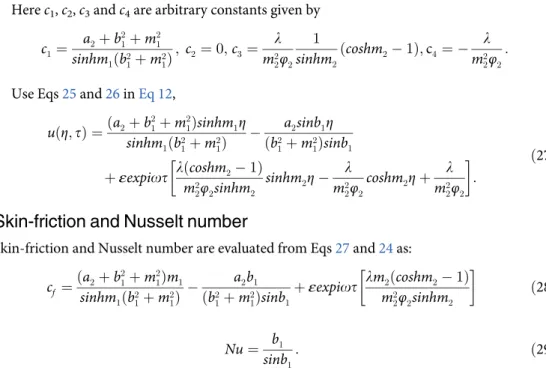
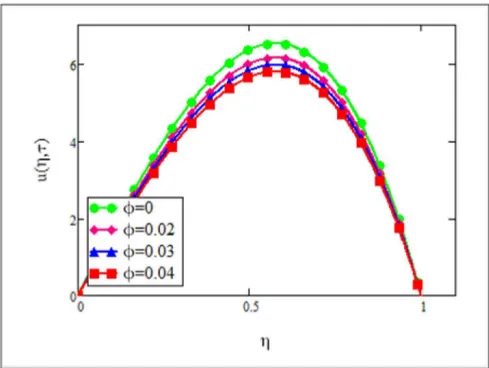
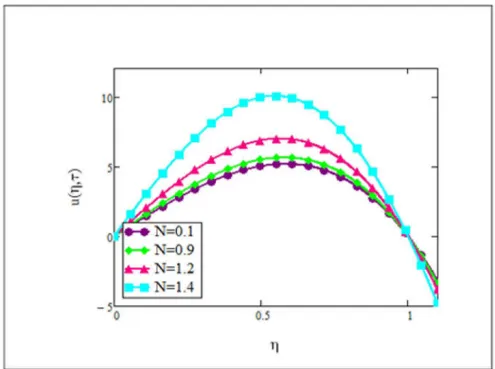
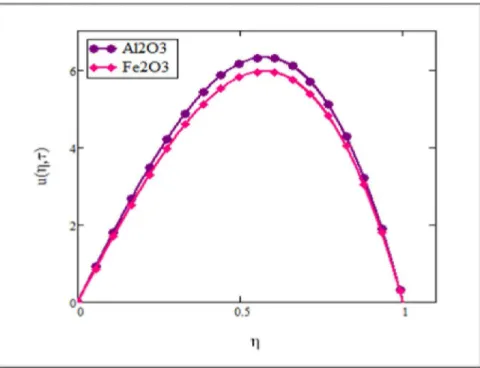
![Fig 8. Comparison of present velocity results φ = 0 with published results of [30].](https://thumb-eu.123doks.com/thumbv2/123dok_br/18310561.348704/11.918.304.817.652.1023/fig-comparison-present-velocity-results-φ-published-results.webp)
